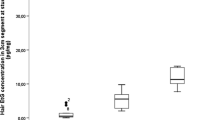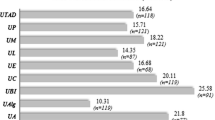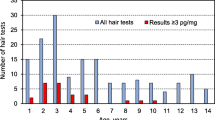Abstract
Ethyl glucuronide (EtG) and fatty acid ethyl esters (FAEEs) are metabolites of alcohol that when detected in hair can provide evidence of a person’s drinking behavior. The analysis of these compounds in hair has become commonplace in recent years and has been used as evidence in legal proceedings. Despite the routine use of such toxicological analysis, the correct interpretation of alcohol biomarker hair testing can be complex, and there may be debate as to the significance of the data. This paper considers whether the accepted norm of applying interpretative cut-off values to EtG and FAEE concentrations from hair samples is appropriate, and asks whether Bayesian theory, using a likelihood ratio approach may offer greater insight as to the strength of evidence. In addition to the complexity of result interpretation in this field, the sensitivity of alcohol biomarkers in hair to distinguish low level drinking from abstinence also represents a significant challenge. The use of fingernail EtG testing as an alternative to hair analysis is explored in this paper and it is proposed that fingernails may in theory show a higher uptake of EtG than hair, and thus show potential as a useful alternative matrix to document long-term low to moderate alcohol consumption.
Similar content being viewed by others
References
Pragst F, Balikova MA. State of the art in hair analysis for detection of drug and alcohol abuse. Clin Chim Acta. 2006;370:17–49.
Pragst F. Interpretation problems in a forensic case of abstinence determination using alcohol markers in hair. Forensic Sci Int. 2012;10(217):1–3.
Society of Hair Testing: 2016 consensus for the use of alcohol markers in hair for assessment of both abstinence and chronic excessive alcohol consumption. http://www.soht.org/images/pdf/Revision%202016_Alcoholmarkers.pdf. Accessed 27 June 2018.
Bossers LCAM, Paul R. Application of Bayesian theory to the reporting of results in alcohol hair testing. Forensic Sci Int. 2014;242:e56–8.
Alladio E, Martyna A, Salomone A, Pirro V, Vincenti M, Zadora G. Evaluation of direct and indirect ethanol biomarkers using a likelihood ratio approach to identify chronic alcohol abusers for forensic purposes. Forensic Sci Int. 2017;271:13–22.
Biedermann A, Taroni F, Bozza S, Augsburger M, Aitken CGG. Critical analysis of forensic cut-offs and legal thresholds: a coherent approach to inference and decision. Forensic Sci Int. 2018;288:72–80.
Cappelle D, Neels H, De Keukeleire S, Fransen E, Dom G, Vermassen A, et al. Ethyl glucuronide in keratinous matrices as biomarker of alcohol use: a correlation study between hair and nails. Forensic Sci Int. 2017;279:187–91.
Funding
We acknowledge funding for part of this work from the Royal Society of Chemistry (RF18-8876).
Author information
Authors and Affiliations
Corresponding author
Ethics declarations
Conflict of interest
The author declares no conflict of interest.
Ethical approval
Bournemouth University ethics committee provided ethical approval for the work on ethyl glucuronide in fingernails.
Informed consent
The author declares that informed consent was sought from all participants relating to this work.
Rights and permissions
About this article
Cite this article
Paul, R. Alcohol markers in hair: an issue of interpretation. Forensic Sci Med Pathol 15, 281–283 (2019). https://doi.org/10.1007/s12024-018-0055-y
Accepted:
Published:
Issue Date:
DOI: https://doi.org/10.1007/s12024-018-0055-y




